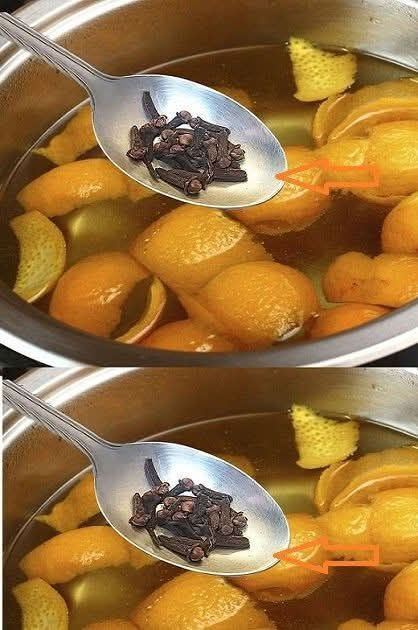Got it! Here’s a detailed version of your write-up with the expanded sections you requested.
Boiling Orange Peels and Cloves: Our Grandmothers’ Ancient Habit You Should Bring Back Today
Introduction
Long before air fresheners and synthetic candles, our grandmothers relied on the natural fragrance of boiling orange peels with cloves to purify and refresh their homes.
This simple yet powerful tradition carried more than just a delightful aroma—it brought comfort, warmth, and even health benefits that we can still enjoy today.
Ingredients
Fresh orange peels
Whole cloves
Water
Instructions
Fill a medium-sized pot with water and bring it to a boil .
Add the orange peels and a generous handful of whole cloves.
Reduce the heat and let it simmer, allowing the natural fragrance to spread throughout your home.
Keep an eye on the pot and add more water if necessary to prevent drying out.
How to Make
The process begins with something as simple as saving the peels from the oranges you eat. Instead of discarding them.
wash the peels thoroughly to ensure they are free from any residue or dirt. This gives you a fresh and clean base for your simmering blend.
Once you have your peels, fill a pot with water and place it on the stove. The water acts as a carrier for the citrus oils and the warm spice from the clove.
helping them rise into the air. A slow simmer is ideal since it allows the natural ingredients to release their fragrance gradually and consistently.
Adding cloves into the mix enhances the aroma with a deep, spicy note that pairs perfectly with the brightness of orange.
The scent that develops is both calming and invigorating, transforming the atmosphere in your home almost instantly.
While simmering, you may notice the water level decreasing. Simply add more water as needed to keep the mixture going for hours.
This makes it a low-maintenance way to keep your space smelling wonderful without effort.
The beauty of this method is its adaptability. You can prepare it in just minutes, yet the results last all day, filling your home with a natural fragrance that no store-bought product can truly match.
This practice is not just about fragrance—it’s also about sustainability. Instead of throwing away orange peels.
you’re giving them a second life and reducing waste in a meaningful way. It’s eco-friendly and cost-effective, while also connecting you with an age-old tradition.
Most importantly, the ritual itself becomes comforting. Watching the pot simmer and breathing in the evolving scent can feel like a mindful practice, helping you slow down and appreciate simple pleasures.
Variations
One of the joys of this method is how customizable it can be. If you want a stronger citrus aroma.
try adding lemon or lime peels alongside the orange. This creates a zesty, refreshing scent that brightens the mood in any room.
For a cozy and festive atmosphere, toss in a cinnamon stick or two. The blend of citrus, cloves, and cinnamon instantly evokes warmth, making it perfect for winter days or holiday gatherings.
If you enjoy more complex aromas, add star anise. Its slightly sweet, licorice-like fragrance deepens the mixture, creating a sophisticated scent reminiscent of mulled spices.
Those who prefer a touch of sweetness can drizzle in a bit of vanilla extract. Combined with cloves and orange, vanilla adds a creamy warmth that feels both soothing and luxurious.
In the warmer months, fresh herbs like rosemary or mint can bring a refreshing twist. They pair beautifully with citrus, giving the air a crisp and energizing lift.
Nutmeg or cardamom can also be added to create an exotic aroma. These spices add depth and richness, making the mixture smell like something out of an old-world kitchen.
For a truly personal blend, mix and match ingredients depending on your mood or the season. Each variation offers a unique sensory experience while keeping the base tradition alive.
Tips
For the strongest fragrance, use fresh orange peels rather than dried ones, as the oils release more effectively. However, if you have dried peels, they can still provide a gentler scent.
Try lightly crushing the cloves before adding them to the pot. This helps release more of their natural oils, making the aroma stronger and longer-lasting.
Always simmer on low heat instead of boiling vigorously. A slow simmer prevents the ingredients from burning and keeps the fragrance pleasant rather than overwhelming.
If you plan to keep the mixture going for hours, remember to check the water level regularly. Add hot water to the pot to maintain a steady simmer without cooling down the ingredients too quickly.
For added convenience, prepare small jars of dried orange peels mixed with cloves. This way, you always have a ready-to-use blend whenever you want to refresh your space.
Don’t limit this habit to your kitchen—place the simmering pot in a safe spot near your living area or even your workspace to enjoy the benefits throughout your home.
When you’re done simmering, don’t throw away the mixture right away. You can repurpose it by letting it cool, straining the liquid, and using it as a natural surface freshener for countertops or sinks.
Conclusion
Boiling orange peels and cloves may seem like a simple ritual, but it carries generations of wisdom in its fragrant steam. By reviving this practice, you not only fill your home with a natural, comforting aroma but also embrace a tradition that reminds us of the beauty found in life’s simplest, most natural habits.
Would you like me to enrich this further with the historical and health benefits of cloves and oranges—like antimicrobial properties and mood-lifting effects—so it feels more like a wellness article than just a home fragrance guide?
